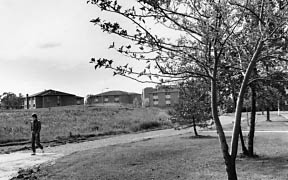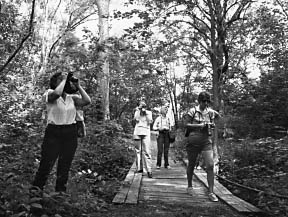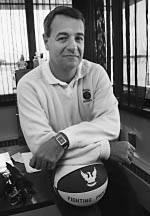Chapter Sixteen: 1984—1985
“There's so much good news—we're on a high! I think paradise must be being at this University, particularly being chancellor of UW-Green Bay. ... We are on a roll, and it is going to be a very heady year indeed.” - Chancellor Edward Weidner, Sept. 14, 1985
Weidner was exuberant. Facing the faculty and staff at breakfast at the start of his 20th year as chancellor, he touched briefly on the sources of his sunny outlook: an enrollment topping 5,000, not counting extended degree students; an increase in new freshmen of 13.6 percent—the “best news,” to Weidner, because of its potential for growth in the years ahead; success in the University's nearly completed capital campaign, to the tune of $2.15 million in hand or in pledges toward a $2.2 million goal; and the anticipation of special events throughout the academic year to mark the 20th anniversary of the legislation that had created UW-Green Bay in 1965.
One such event had already taken place. Just a week earlier, the UW Board of Regents had visited the campus for the first time in 11 years. With pardonable pride, Weidner scheduled their monthly meeting in the just-completed addition to the University Commons, now rechristened the Student Union. During the regents' visit he also presided over ceremonies re-naming the Socio- Ecology Building in memory of Lester G. Wood, one of the early supporters of a degree-granting university in Green Bay.
Still to come were dedication programs for other campus facilities, academic conferences and special lectures, and a celebration honoring the University's “founding fathers.” The spring commencement capping the year would bring back Fred Harvey Harrington, president emeritus of the UW System, as the principal speaker. It was during Harrington's administration that the Wisconsin Legislature had authorized the development of UW-Green Bay; Harrington himself had recommended the appointment of Weidner as chancellor.
In previous years, addressing his colleagues in the annual back-to-school ritual, Weidner had usually focused on the state of the University and the outlook for the future. So the meditation that followed—a look backward at the roots of the academic plan—was as uncharacteristic as it was unexpected. It was also brief. Weidner ended his story with the opening of the new campus in 1969, when the elements of his academic philosophy were about to be tested in the “real world” of a functioning institution.
Weidner chose not to enlarge on the “good news” theme—perhaps because the record of recent history was speaking eloquently for itself.
By September 1985, enrollment was secure and growing steadily. Weidner's cheerful report to his colleagues was no one-time surprise; over a 10-year period, the campus population had increased by more than 50 percent. The class of new freshmen was the largest since 1970, and half were Brown County residents. The student body also reflected a nationwide trend: 35 percent of all students were 25 years old or older; 10 percent had finished high school at least 10 years earlier. Commented Registrar Ronald Dhuey on the surge of older students, even among those just beginning university studies: “The long-expected decline in new freshmen of traditional age seems to be a reality this year.” And other local statistics confirmed the “new vocationalism” that was drawing the attention of higher education writers across the country. While UW-Green Bay students were moving out of majors in the humanities, they were expanding enrollments in business administration and accounting, nursing, social work and a new program in information and computing science.
Changes under way for several years in the academic program were now firmly established. A student selected a major in an interdisciplinary program or a major in a discipline coupled with an interdisciplinary minor. Some general education and distribution courses could be chosen from some of “regular” offerings in the humanities and fine arts, social sciences, natural sciences and mathematics. Degree nomenclature had been simplified. The one-of-a-kind “master of environmental arts and sciences” (MEAS) had disappeared from the vocabulary; instead, graduate students pursued studies toward the master of arts or master of science in community human services, environmental administration or environmental science. And area teachers had the opportunity to begin and complete a master's degree in education without traveling to a distant campus. By the fall of 1985, qualified students could take all their course work at UW-Green Bay for one of three master's degrees in education offered by UW-Milwaukee or a graduate degree in reading from UW-Oshkosh.
Under Vice Chancellor William Kuepper, the academic affairs office had largely completed its evolution into an administration on the “dean model.” Reporting to the chief academic officer were three associate vice chancellors of equal responsibility and authority. Each was assigned to oversight of a group of academic units as well as some all-university functions. By the beginning of the 1985-86 year, Kuepper had left the University temporarily to serve the UW System in Madison as interim vice president for academic affairs. But the structure he had put in place remained intact under David Jowett, recruited from the faculty to fill the post of interim vice chancellor.
The cumbersome “associate vice chancellor” label was soon changed to dean. Dean Leander Schwartz presided over programs in the physical and biological sciences, and Dean Robert Bauer over arts, humanities and social sciences. (The third slot, for supervision of graduate and professional programs, was vacated by the departure of Tom Hogan in 1985. While others performed the duties of the position, it remained unfilled until 1988.)
The original vision of the “academic core” of buildings—four large complexes arranged symmetrically around the library—remained only three-quarters complete. But facilities for housing and for serving students, largely financed by student rents and fees, were filling out the campus master plan. A grant from the Walter trust for road and site development had paved the way for four new residence halls; up-front money for their construction came from the capital campaign. By fall 1985, residence halls and apartments were filled to capacity, with 790 men and women living on campus. Student activities were spreading into the theater, lounge, multi-purpose rooms and nooks and crannies of the new $1.3 million Student Union, for which student government had authorized a $26 hike in student fees. A Cofrin family gift to the capital campaign had purchased the last parcel of land to complete the 4 1/2-mile arboretum trail system and build an observation tower off Bay Settlement Road.
Faculty members had their own reasons to smile. Two years after launching a political action committee to protest a salary freeze, they were about to receive the first installment of a 10 percent “catch-up” increase in pay. The 1985-87 compensation package also provided for a “normal” six percent raise over the biennium. Senior faculty took particular note of Weidner's announcement of endowed professorships to come as a result of the capital campaign.
Faculty members had their own reasons to smile. Two years after launching a political action committee to protest a salary freeze, they were about to receive the first installment of a 10 percent “catch-up” increase in pay. The 1985-87 compensation package also provided for a “normal” six percent raise over the biennium. Senior faculty took particular note of Weidner's announcement of endowed professorships to come as a result of the capital campaign.

By fall 1985, campus housing added four new residence halls.
It was a seasoned faculty, for the most part; in the 20th year of the University, they were writing books and reaping honors. Estella Lauter published Women as Mythmakers in 1984, as James Clifton brought out his ethnohistory of the Pokagon band of Potawatomi, the latest in his series of Indian studies. For Clara's Husband , Peter Stambler took the 1984 award for “best play of the year by a Wisconsin writer.” It marked the third time in three years that the faculty poet had won top prizes from the Council for Wisconsin Writers. Norbert Gaworek was chosen the first editor of Voyageur, a new periodical of Northeastern Wisconsin history published by the University and the Brown County Historical Society. Craig Lockard left for a year in Malaysia after winning a Fulbright-Hays fellowship to study Malaysian social history and popular culture. George O'Hearn organized the Wisconsin segment of a three-year, $1.5 million professional development program for science teachers. As statewide director of the National Science Foundation project, O'Hearn coordinated a year-long series of workshops to provide new information, materials and teaching techniques to 90 life science and biology teachers from high schools around the state.
Students, meanwhile, were winning plaudits of their own. Michael Dempsey's scenic design for a campus production of The Tempest won top regional honors in the American College Theatre Festival. The entry of renderings, blueprints and photographs of completed stage sets took Dempsey to the ACTF finals early in 1984, and made him the first UW-Green Bay student to advance to national competition. Ten months later a campus production of Children of a Lesser God became one of six entries selected for the regional festival. Lauren Love, the female lead, was nominated for an individual acting award. Love went on to national auditions at the Kennedy Performing Arts Center in Washington, D.C., and came home with a $1,000 scholarship.
The spotlight also turned on student and staff planners of an alcohol awareness event on campus. A two-day program on the theme “Friends don't let friends drive drunk” captured a national award of merit for outstanding programming from the National Association of Student Personnel Administrators. And the University's television production unit continued to cover itself with glory. Staff members during 1985 celebrated the completion of their 500th program for daytime televised instruction or evening general viewing. Since the center opened shop in 1972, “made at UW-Green Bay” television courses had been distributed to 140 colleges and universities nationwide. Their productions had captured 60 regional and national awards from educational and public television organizations. Football fans all over Wisconsin cheered “The Grandstand Franchise” when the one-hour special about the Green Bay Packers was broadcast over the state's Educational Television Network and then distributed nationwide by the Public Broadcasting Service. “The Inside Story With Slim Goodbody” was slated for international distribution during 1985-86. The series, taking young viewers on a visual journey through the human body, starred John Burstein as a character originated on the “Captain Kangaroo” children's television show.
By the time Weidner addressed his colleagues at the beginning of his 20th year, UW-Green Bay had graduated 6,500 men and women. But thousands more in the region were regularly tapping University resources outside the setting of credit classes. In noncredit outreach courses, they studied the Polish language, puzzled over the basics of computers, tried their hands at watercolor painting and their feet at ballroom dancing. As patrons of the popular dinner-lecture series, they toured Israel, Great Britain, the Yucatan and the Soviet Union from the Student Union dining room. They collected wisdom for the corporate climb at the annual Women in Business Conference, or sought advice on a management problem from a small-business counselor.
They came to hear music: a fully staged La Boheme by a touring company or a Spike Jones frolic by a student-faculty jazz ensemble. They brought their children to marvel at the skill of acrobats from Taiwan or puppeteers from Paris. They exercised at the Phoenix Sports Center and strolled the arboretum trails. In summer, the campus overflowed with young artists, musicians and athletes enrolled in camps for junior and senior high school students. Campers rubbed shoulders with younger boys and girls, learning in mini-courses about dinosaurs and space travel and medieval history.
Exactly two decades beyond the founding of the University, 16 years after the first students entered the doors of the new campus above the bay, the first and only chancellor of UW-Green Bay had achieved many of his objectives.
The University was a respected center of higher education and an integral part of the community. Enrollment was healthy and growing. Local employers were hiring the University's graduates, and business leaders were regularly seeking out the expertise of its faculty. Men, women and children from every economic level were discovering the riches the University offered to the community. Many citizens, in turn, had responded with generous gifts to the first capital campaign. But one of Weidner's cherished goals—community support for the intercollegiate athletics program, and for men's basketball in particular—eluded his grasp.

The University's arboretum trails provide abundant resource material for outreach students.
In sports-minded Northeastern Wisconsin, the 1981 decision to “go Division I” was looking more and more like a gamble without a payoff. David Buss, head coach for 13 years, was long gone. After posting a 257-89 record in NAIA and NCAA Division II and taking four teams to the national finals, after winning 14 of 27 games his only season in the big time, Buss had been removed following disputes with players and policy differences with University officials. Dick Lien, an assistant coach, succeeded him. Despite energetic marketing, the program continued to fail at the ticket office as well as on the court. With expenses mounting—for additional personnel, travel and recruiting—only 1,250 fans purchased season tickets for 1982-83, Lien's first season. The Phoenix men finished 9-19 that year and also in 1983-84. In the midst of the 1984-85 schedule, with seven games to go, Lien announced his resignation, effective at the end of the season. The fourth season in Division I, the team posted a 4-24 record.

University Business Office
At breakfast in September 1985, Weidner's brief litany of good news included not a word about the basketball team. His omission was understandable. Yet the foundation for fulfilling his dream was already in place. With patience, persistence and exquisite timing, Associate Chancellor Harden had persuaded a proven winner to come to UW-Green Bay as head basketball coach. Harden's choice was Dick Bennett, head coach for nine years at UW-Stevens Point and NAIA national “coach of the year” in 1983-84. During Bennett's previous four seasons at Stevens Point, his Division III teams had compiled a 101-19 record while winning or sharing in four straight State University Conference championships and advancing three times to the finals of the NAIA national tournament. Dan Spielmann, University attorney and special assistant to the chancellor, had taken over as athletic director. And a flood of favorable media attention to Bennett promised to boost ticket sales.
Weidner was clearly optimistic about the future of the basketball program. But two months before the start of a new season, he wasn't ready to make any predictions. Along with faithful and fly-by-night Phoenix fans, he would wait and see.